Table of Contents
Mixing of Concrete
The method of appropriately mixing the materials needed to produce concrete, such as cement, fine and coarse aggregate, water, and admixtures (if any), is known as the mixing of concrete.
Cement, sand, aggregates, and water, are all mixed together in definite proportion to produce the hardened mass known as concrete.
It serves as the primary building material. It is crucial to the building’s usability and durability.
In addition to the concrete itself, other concrete production operations including batching, mixing, transporting, placing compacting, finishing, and curing also plays a big part.
Despite how simple it is to make concrete, doing it right is much more complex and delicate, especially when the materials are mixed.
Concrete mixing is an especially tough operation. We simply need to adhere to a few standard mixing techniques to produce high-quality concrete.
Making concrete is not enough, but producing high-quality concrete is crucial.
The same materials are used in both the production of high-quality and low-quality concrete, but the ratio and mixing technique can make a difference.
To produce high-quality concrete, proper attention and knowledge are needed.
In order to produce the various grades of concrete and reach the design strength of concrete, the concrete components must be appropriately mixed in accordance with the concrete mix design.
Importance of Mixing of Concrete
In order to create high-quality fresh concrete, proper mixing of the elements is crucial.
All of the aggregate particles’ surfaces are covered with cement paste during mixing.
The ideal workability and performance of concrete in both fresh and hardened states depends on properly mixed concrete.
Concrete has a tendency to segregate and bleed if it is not properly mixed.
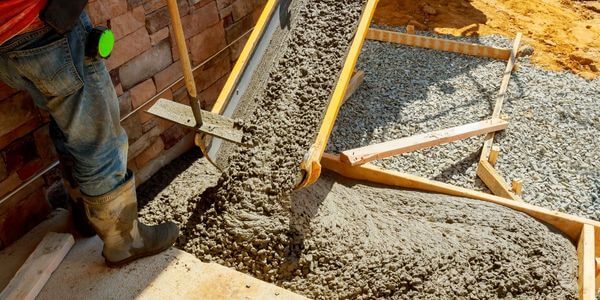
Making the mass of concrete homogeneous and uniformly colored while retaining the appropriate uniformity is the basic objective of concrete mixing.
The cement paste should cover every aggregate particle, and the various components of the concrete should combine to form a single, homogeneous mass.
This procedure is so essential that improper mixing of the elements for concrete production might result in weak concrete portions and concrete failure under compression load.
As a result, adequate safety measures should be taken when mixing concrete.
Characteristics of well-mixed concrete
- The color of the concrete should remain constant.
- Cement, fine and coarse particles, and water should all be mixed uniformly when making concrete.
- Cement paste should cover the aggregate’s whole surface.
- Segregation or bleeding shouldn’t occur after the concrete has been mixed.
Methods of Mixing of Concrete
The following three concrete mixing techniques are used to produce concrete that is efficient and of high quality.
- Hand Mixing of Concrete
- Machine Mixing of Concrete
- Ready-mixed concrete
Different forms of concrete mixing are needed for various constructions. Utilizing the proper concrete mixing technique for the intended usage and application is crucial for a successful outcome. The process of mixing concrete is affected by a number of elements, including,
- Location of the building site with enough space for the activities involved in construction, such as densely populated urban regions
- Space available for batching, mixing of concrete, and storing materials required for the production of concrete.
- Required concrete volume
- The construction schedule includes details such as the amount of concrete needed each hour or day.
- The height at which the concrete will be placed.
- Cost
Let’s examine each of the three concrete mixing techniques in more depth.
Hand Mixing of Concrete
For modest, insignificant concrete projects, hand mixing of concrete is used. It is advisable to add 10% additional cement to this approach.
Because the material mixing is insufficient compared to machine mixing, leading to the production of subpar concrete.
If concrete is made using manual mixing, It needs to be done on a surface made of impervious brick or concrete that is big enough to hold one bag of cement.
Initially, spread the aggregate and sand on alternate layers in equal or measured proportions.
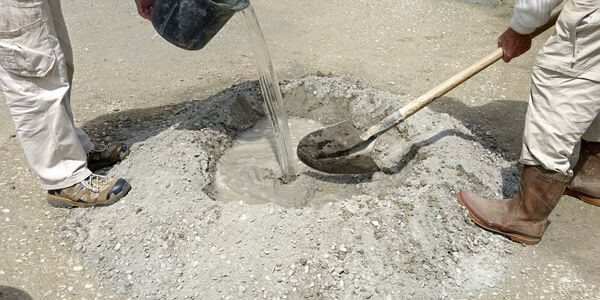
Cement should be added on top of this and mixed dry with a shovel, rotating the mixture repeatedly to achieve color uniformity. Mix these ingredients thoroughly with the use of an appropriate tool.
The ingredients are thoroughly mixed before the water is introduced. The mixing process is continued after the water has been added until an excellent, consistent, homogenous mix has been achieved.
Avoid overwatering concrete and make sure to use all of the water that is mixed in. Concrete is ready for usage after it has been thoroughly mixed.
Machine Mixing of Concrete
Concrete mixing is done using the machine for RCC concrete and medium- or large-scale mass concrete job.
When producing a significant amount of concrete, using a mixer is not only productive but also cost-effective.
Unlike continuous mixers, which make concrete constantly without interruption while the facility is operating, these types of mixers produce concrete in batches.
Screw feeders are used to filling the next batch with continuous material, which is continually mixed and released during the process.
There could be two different drums or pans in the batch mixer. Additional classifications for the drum type of mixer include tilting, non-tilting, reversing, and forceful action types.
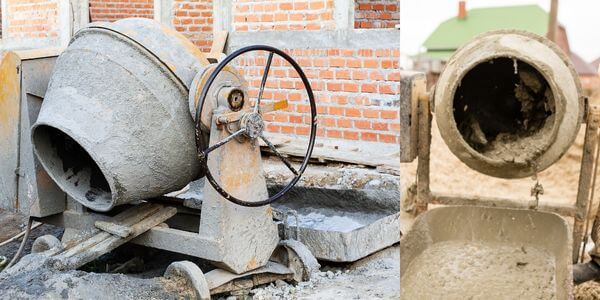
There hasn’t been a thorough investigation of the mixing effectiveness of the various types of mixers, but some data points to the superiority of pan mixers with rotating blade stars.
This type of mixer is best suited for stiff and lean mixtures, which causes challenges for most other mixer types due to the mortar’s propensity to adhere to the drum.
The size, angle, and form of the blades, as well as the angle at which the drum is held, all have a significant impact on the mixer’s efficiency.
The discharging drum is not a tilting drum; a chute is fed into the drum by pulling a lever.
A tilting drum has been found to sometimes be more effective than a non-tilting drum. The concrete mixed in the drum discharges into the inclined chute using these chutes.
Typically, 50 kg of cement should be used to create a batch of concrete. If you’re planning to buy a mixer, be sure it has enough capacity to hold everything you need to make one bag of cement concrete.
For 1:2:4 mixtures, the optimal mixer has a 200-liter capacity, for instance. For a mix ratio of 1: 3: 6, 280 liters of capacity are needed to facilitate one bag of mix.
The 200-liter mixer might not be effective for a 1 : 3: 6 mix, while the 280-liter mixer is too large and therefore uneconomical for a 1: 2: 4 concrete mix.
To obtain a high-quality concrete mix, perform the steps listed below:
- Place half of it in the drum first, then pour roughly half of the fine aggregate over it.
- The remaining quantities of coarse aggregate and fine aggregate are then sequentially deposited over the complete amount of cement that has been poured into one bag in this location.
- This order of material addition can prevent cement from overflowing while being discharged into the skip and from being blown away in windy conditions.
- Before adding skip discharge material to the drum, add 25% of the total amount of water needed for mixing. This will moisten the drum and prevent cement from adhering to its bottom or blades.
- Immediately after the dry material has been poured into the drum, the remaining 75% of water is added to it.
Ready Mix Concrete
Conventional concrete is frequently produced on-site in India using labor and basic equipment, such as mixer machines. But ready-mixed concrete is also gaining popularity in modern times.
A specialized material called ready-mixed concrete (RMC) has its cement, aggregates, and other components weighed and batched at a plant in the middle of nowhere.
Prior to being delivered to the construction site in a state ready for customer placement, the material is then combined, either in a central mixer or in truck mixers.
The finished concrete has substantially higher quality than site-mixed concrete, which includes both hand-mixed and machine-mixed concrete.
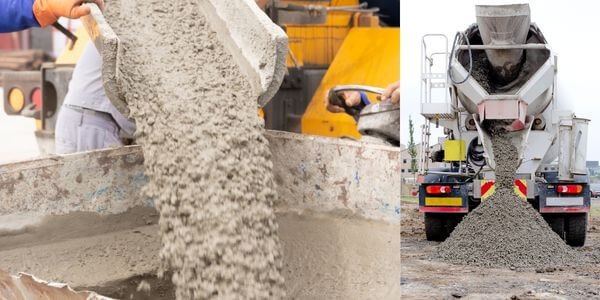
When building roads or on crowded construction sites where there is little to no room for a mixing plant or for the storage of aggregates, ready-mixed concrete is especially helpful.
Because the batching and mixing are carried out at a mechanized central batching facility, quality control of the concrete produced using this approach is simple.
This mixing technique is highly helpful in a variety of settings, including crowded regions, at night when pouring concrete, at sizable construction sites, etc.
In contrast to other mixing procedures, the water-to-cement ratio can be easily regulated in ready-mixed concrete.
The admixtures, or fly ash and cement, can be combined in precise measurements or proportions;
otherwise, excessive usage of construction chemicals may occur. The usage of ready-mixed concrete can also help to avoid these problems.
Concrete Mixing Time
Typically, the mixer is made to spin at a rate of 15 to 20 revolutions per minute.
In a well-designed mixer, it is observed that between 25 and 30 revolutions are needed for properly mixed concrete.
On a building site, the typical inclination is to reduce the mixing time to speed up the output of concrete. As a result, the concrete is of lower quality.
In terms of the pace of concrete output and fuel consumption, running the mixer for an extended period of time is uneconomical.
As a result, the amount of time the concrete is mixed in the mixer is a crucial component that should be considered carefully.
According to research data, the quality of concrete will get better with more mixing time in terms of compressive strength.
The compressive strength does not significantly improve when mixing takes longer than two minutes.
Concrete’s compressive strength and mixing time are compared in Fig. 1.
Generally, the mixing time of the mixer is related to its capacity. The time spent mixing in the drum varies between 112 and 212 minutes. The mixing time increases with the size or capacity of the drum.
However, the mixer can effectively mix in between 15 and 30 seconds while generating ready-mixed concrete.
For batching and mixing, a high-speed pan mixer with a 1-cubic-meter capacity only needs roughly 2 minutes.
Loading a transit mixer with a 6 m3 capacity from the RMC batching facility takes about 12 minutes.
Batching of Concrete
“Batching of concrete” refers to estimating the right and appropriate amount of materials for creating concrete.
To maintain consistency of proportions and aggregate grading throughout batches of concrete, accurate and proper measurement of every material used is crucial.
- Volume Batching
- Weigh Batching
Volume Batching
Because measuring granular material in terms of volume is difficult, volumetric batching is a fairly precise approach for creating concrete.
It is a proven fact that a given volume of moist, loose sand weighs significantly less than a comparable volume of dry, compacted sand.
A cubic meter’s worth of solid stuff can never be precisely measured. Weigh batching is more practical for producing concrete that is more precise and of higher quality.
On-site mixed concrete, however, is unable to weigh such a substantial amount of material. Volume batching may be utilized in this case. Every time cement is used, it is weighed, not volumetrically.
Typically, one bag of cement is required for every batch of concrete. The capacity of a single bag of cement is 35 liters.
A gauge box or volume box or measuring box with a fixed size is used to measure out an amount of both fine and coarse aggregates. The figure depicts a gauge box of the typical size.
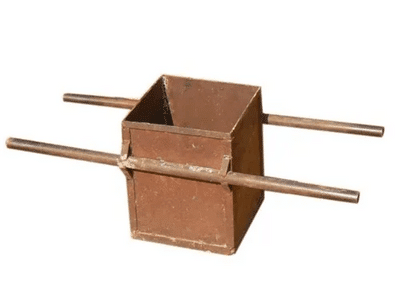
The box has a volume of 35 liters or multiples thereof, weighs the same as one bag of cement, and is manufactured of that volume.
To make it simpler to estimate top-level, gauge boxes are constructed with a top-narrow surface rather than a shallow surface with a larger surface.
Farmas are more commonly used terms for gauge boxes or volume boxes. They may be constructed from steel plates or wood. Large-scale concrete plants in India also employ volume batching.
The following gauge boxes for the site take into account changes in mix design or sand bulking for significant major sites. Each gauge box has a painted external surface that is clearly labeled with the volume.
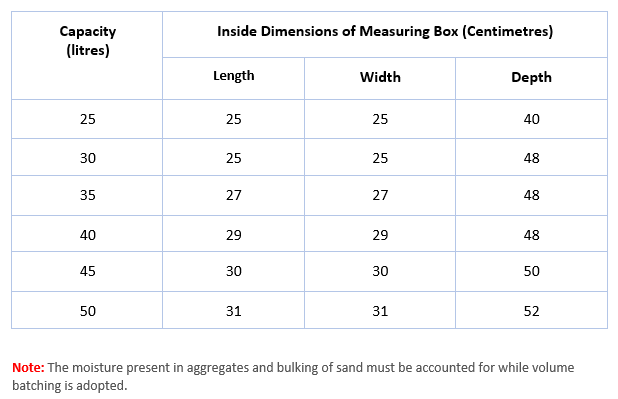
Water can be weighed or measured in liters. Water’s density of one kilogram per liter is the cause of the issue.
The weight of the cement and the water-to-cement ratio indicates how much water is required.
For instance, if a 0.5 water-cement ratio is required, then 0.5 x 50.00 = 25 kilograms or 25 liters of mixing water are needed per bag of cement.
Of course, the amount includes any surface moisture that may be present in the aggregate. The table below shows the rough moisture content that aggregate carries:
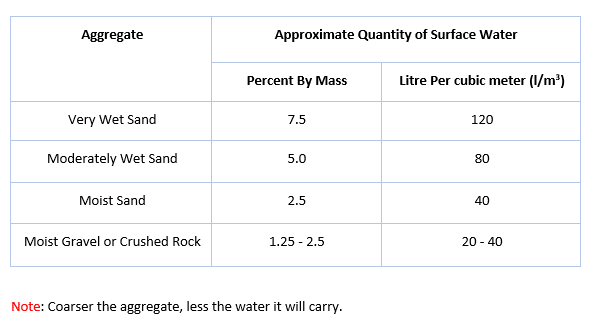
Weigh Batching
Concrete can be made accurately by weighing batches. The weight-batching method of producing concrete is advised in many nations’ standards for usage in significant government projects.
Concrete weight batching makes it easier to be precise, adaptable, and simple. There are numerous batch-weighing options available.
A particular kind might be selected based on the project’s requirements. Automatic weighing equipment is present in large batching operations.
Because of how sophisticated this automatic equipment is to use for batching, engineers with training and expertise are needed.
Materials are weighed using bucket-style machinery on sizable construction sites.
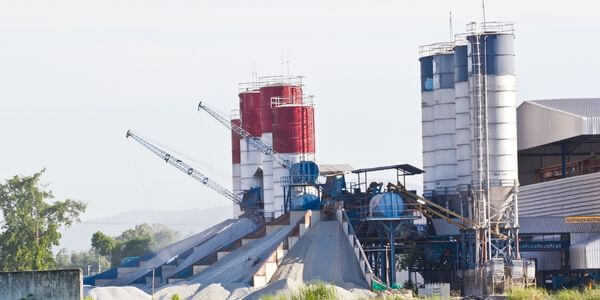
This draws the material from a sizable storage hopper and releases it directly into the mixer through gravity.
Two interconnected beams, jockey weights, and a lever-arm mechanism are used to weigh the material.
With only the lower beam in use, the necessary amount of, let’s say, coarse aggregate is weighed.
After reaching equilibrium, the smaller lever to the left of the beam is turned, adding more fine aggregate until the two beams are balanced. The two beams are connected.
The scale’s pointer, which is situated to the right of the beams, shows the final balance. It is released via a swivel gate at the base. There are small and huge capacities for these autonomous plants.
In this, the operator simply needs to press one or two buttons to start the weighing of all the various materials.
Each material’s flow is then stopped after the desired weight is attained. In their most sophisticated forms, automatic plants are powered by electricity and a punched card system.
These kinds of plants are most suited for producing ready-mixed concrete when very frequent adjustments to the mix proportions are necessary to satisfy various customers’ differing needs.
Water Quantity for Mixing of Concrete
While we opt to weigh batches, correct water measurement is still necessary. Due to water spillage and other issues, adding buckets with graduations in liters won’t be accurate enough.
Typically, it is measured in a tank mounted to the mixer, either horizontally or vertically. In between batches, these tanks are emptied and then refilled.
The tank filling is so precise that it can accommodate any desired water volume.
Water meters that are mounted in the mixer’s main water supply are occasionally used for this task so that the precise amount of water can be poured into the mixer.
Concrete Transportation
Concrete is moved using a variety of tools and ways on the job site. The only precaution that has to be taken is to ensure that the homogeneity of the concrete obtained during mixing is maintained all the way to the intended location.
The following transportation strategies have been used: There are several ways to transport concrete, including Belt Conveyors, Chut, Hand Carts, Helicopters, Mortar Pan, Pump, and Pipe Line, Ropeway Crane Buckets, Skip and hoist Transit Mixer, Truck Mixer Dumpers, Wheel Barrow
FAQs
What is the mixing of concrete?
The “full blending of the components necessary for the formation of homogeneous concrete” is the definition of mixing concrete in its simplest form. The mixing method here can range from hand to machine, with machine mixing being the most typical.
What are the methods used for the mixing of concrete?
The following three concrete mixing techniques are used to produce concrete that is efficient and of high quality.
Manual concrete mixing (mixing concrete manually without a mixer machine)
Concrete is mixed by machine (mixing concrete with a mixer machine)
Ready-mixed concrete (mixing in an automatic or semi-automatic batching plant)
What is hand mixing of concrete?
Hand mixing of concrete refers to the process of manually combining the various components of concrete. For modest tasks that only need a small amount of concrete, hand mixing may be used.
What is the mix ratio for concrete?
A normal concrete mix would consist of 1 part cement, 2 parts sand, and 4 parts aggregates, but the exact ratio would depend on the level of strength you want to attain. Foundations can be built using a mixture of one part cement, three parts fine aggregate, and six parts coarse aggregate.
Also, Read
Compaction Factor Test For Concrete Workability
Initial and Final Setting Time Test of Cement
Soundness Test of Cement By Le-chatelier’s Apparatus
Specific Gravity of Cement – Definition, Importance